Crustaceans are primarily a marine and aquatic group, they are often easily identifiable as they have a hard exoskeleton with a carapace on top like a shield and many jointed appendages under the body that may be very similar or in 2 or 3 different structural groups.
Crustacea - Crustaceans Crusta - shell
Typical Crustacea
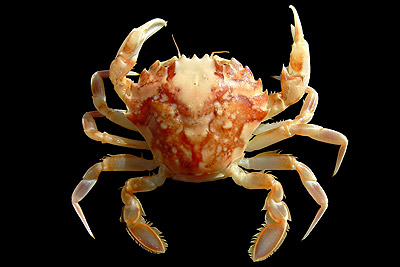
A marbled swimming crab,
Liocarcinus marmoreus
A typical crab
shape with the front appendages as claws and the rear
as flattened swimming paddles allowing them to swim
in the water column unlike other crabs.
picture - Hans Hillewaert,
used under CC4 Attribution Share Alike Licence
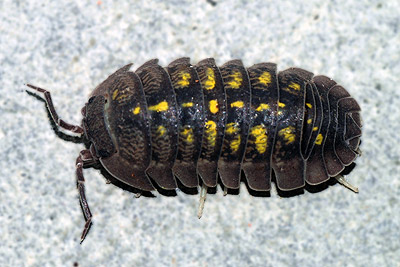
A woodlouse or pill bug
A commonly found Crustacean in damp places
where there is decaying vegetable matter, especially
wood. Fully terrestrial which is uncommon for Crustaceans.
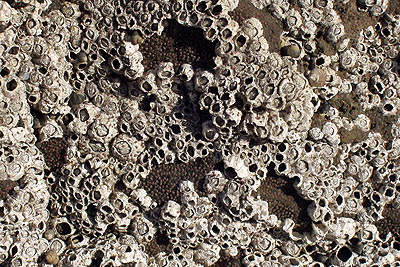
Barnacles
As they
are usually seen at low tide when exposed to the air
with the lids tightly held down. The ones with a hole
in are the dead empty shells of barnacles that may have
been eaten by predatory whelks, these can be seen as
the typically shaped snail shells to the top right of
picture centre. The barnacles with closed white lids
are the live ones, when the tide comes in the "doors"
open and filter feeding legs go to work.
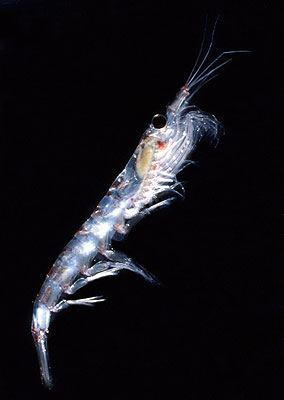
Krill - Euphausia superba
A contender for possibly the most successful
animal species on the planet, individually a maximum
of 6cm long, but with a standing biomass of as much
as 500 million tonnes
Cool Crustacea

Hermit crab
There
are many species of hermit crab found around the world.
Hermit crabs save their energy by not building a large
strong carapace of their own, but by moving into discarded
shells usually of Gastropod molluscs that they find.
When the crab grows larger, it has to find a new shell
to accommodate it. New shells are highly prized, at
times hermit crabs may accumulate together in decsending
size, once a big crab moves into a new shell, its shell
is available for a slightly smaller one.
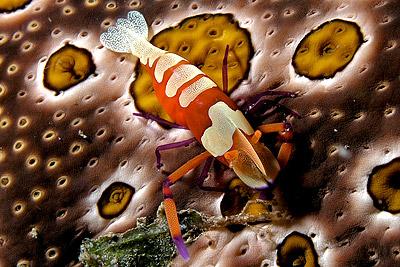
A tropical shrimp, Periclimenes
imperator Emperor shrimp on a sea cucumber.
Almost a colour overload on a tropical reef.
picture - Nhobgood, Nick Hobgood
used under CC3 Attribution Share Alike Unported licencea
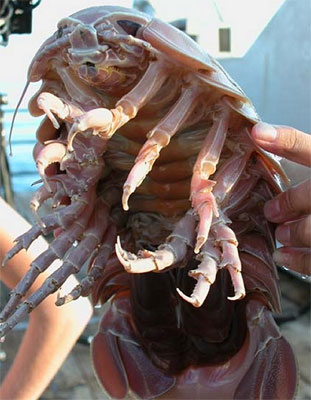
"Charismatic megafauna"
- the deep sea crustacean, Bathynomis giganteus.
Picture courtesy
NOAA
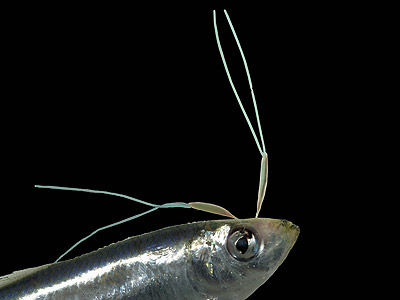
Eye maggot of sprat
Parasitic Copepod Crustaceans are attached
to the eye of this fish. The long pair of threads trailing
from each parasite are egg sacs.
picture - Hans Hillewaert
(Lycaon), published under CC2.5 Attribution ShareAlike
License
Kingdom - Animalia
Phylum - Arthropoda
Superclass - Crustacea
Basic Features:
Crustaceans are a Superclass in the Phylum Arthropoda, so they have all of the characteristics of the Arthropods.
- Two pairs of antennae - the distinguishing feature of Crustaceans
- A well defined head in most members of the group
- The trunk region usually has an abdomen and thorax present
- The trunk section is often covered by a dorsal (on the back) carapace (shell)
- There are often a number of appendages (legs and leg-like things) present that have specialized functions such as feeding, walking and swimming
- The exoskeleton may be strengthened by the addition of calcium carbonate
What do crustaceans eat?
The crustaceans are a large and widely varied group and so have members that feed in most ways, there are however trends in certain groups.
Predation and scavenging - there are many members who have appendages that are modified into claws of various sizes to be able to pick up food and direct it into the mouth. These can be put to work picking up small morsels of found food whether from the messy eating habits of other animals, from carrion or by catching and killing prey such as molluscs or other Crustaceans for which large, strong claws are needed.
Filter feeding- filter feeding in arthropods uses structures called setae rather than cilia as it done in the molluscs. These are very fine combs that are formed on some of the thoracic appendages (legs on the segments of the thorax - middle body bit). Water currents for the efficient operation of the filters are often set up by the beating of other appendages that the animal has.
Filter feeding seems to have evolved independently a number of times in Crustaceans as different appendages are used by different members, not always the same ones.
Parasitism- Another feeding method that has evolved independently several times in the Crustacea. Crustacean parasites are often very much simplified, typically they are external to the host and appear to be a trailing soft appendage, the feeding part is embedded in the flesh. They are parasites of a great many species from other crustaceans to fish and whales.
What eats crustaceans?
People - crabs, lobsters, shrimp and crayfish - what's not to like?!
Crustaceans have many predators depending on their mode of life:
Planktonic crustaceans- Copepods make up a large proportion of the zooplankton in many parts of the world with Krill being prevalent in the Antarctic Ocean. They are very important in that they take the energy trapped by phytoplankton, the tiny floating plants that live in the surface water layers and make them available to larger animals that cannot filter out the tiny phytoplankton, but can filter the larger zooplankton.
Planktonic Crustaceans in vast quantities are eaten by fish and baleen whales, the larger planktonic species are also eaten by squid and small birds and other animals that hunt them individually rather than by filter feeding.

Juvenile herring hunt for the very alert and
evasive copepods in schools: The copepods can
sense with their antennae the pressure-wave of the approaching
herring and react with a fast escape jump. The length
of the jump is quite consistent. The fish arrange in
a grid of this characteristic jumplength. The copepods
can dart about 80 times before they tire out. It takes
60 milliseconds to spread out the antennae again, and
this timeslot is utilized by the herring to finally
snap a copepod. A single juvenile herring would never
be able to catch a large copepod.
picture - Uwe Kils, published
under GNU Free Documentation
License, Version 1.2
Barnacles- These are a difficult prey due to their calcareous shell which can be clamped tight shut, they also tend to be individually quite small, so it can be a lot of effort for little food reward to open them up. There are however specialist predators that feed on them such as some Gastropod Molluscs that drill through the shell with a specialized radula.
Decapod Crustaceans- crabs, lobsters, shrimp and crayfish amongst others. These are particularly attractive prey as they have very muscular tails which are designed to beat quickly and propel them backwards, also the large claws have much muscle so making an attractive prize for a predator. They are difficult animals to eat however as those large claws can be formidable weapons, also they tend to have a very strong resilient carapace made basically of chitin and toughened with large amounts of calcium carbonate (limestone).
The group includes:
- Brachiopods - generally small
animals found in fresh water
- Fairy shrimps
- Daphnia - water fleas
- Copepods - mainly a marine
group
- a very important member of the zooplankton in many regions, usually quite small 1mm to several mm in length
- Many parasitic forms particularly on fish
- Cirripedia - the barnacles,
the only sessile group of Crustaceans, anatomically
the most unusual members of the group, not identified
as such until 1830 when the larval stages were discovered,
until then they had been thought to be molluscs.
According to one lecturer when I was at University
"An unusual group of animals that live standing
on their heads, feeding with their legs and peeing
out of their elbow"
- Stalked barnacles such as the goose barnacle
- Balanus, a common genus whose members look like tiny volcanoes
- Many parasitic forms that look nothing like
other barnacles or in any way like arthropods
- Malacostraca, contains about
75% of all known species of Crustaceans:
- Crabs
- Lobsters
- Shrimps
- Crayfish
- Also many others such as
- Whale lice
- Woodlice (pill bugs)
- Gammarus
- Krill, as found in Antarctic waters and the base of much of the marine ecosystem there
Barnacle feeding and copulation
Christmas Island crab migration
Top banner picture - Peacock Mantis Shrimp, Odontodactylus scyllarus. Picture - Bernard DUPONT from FRANCE, used under Creative Commons Attribution-Share Alike 2.0 Generic license.
